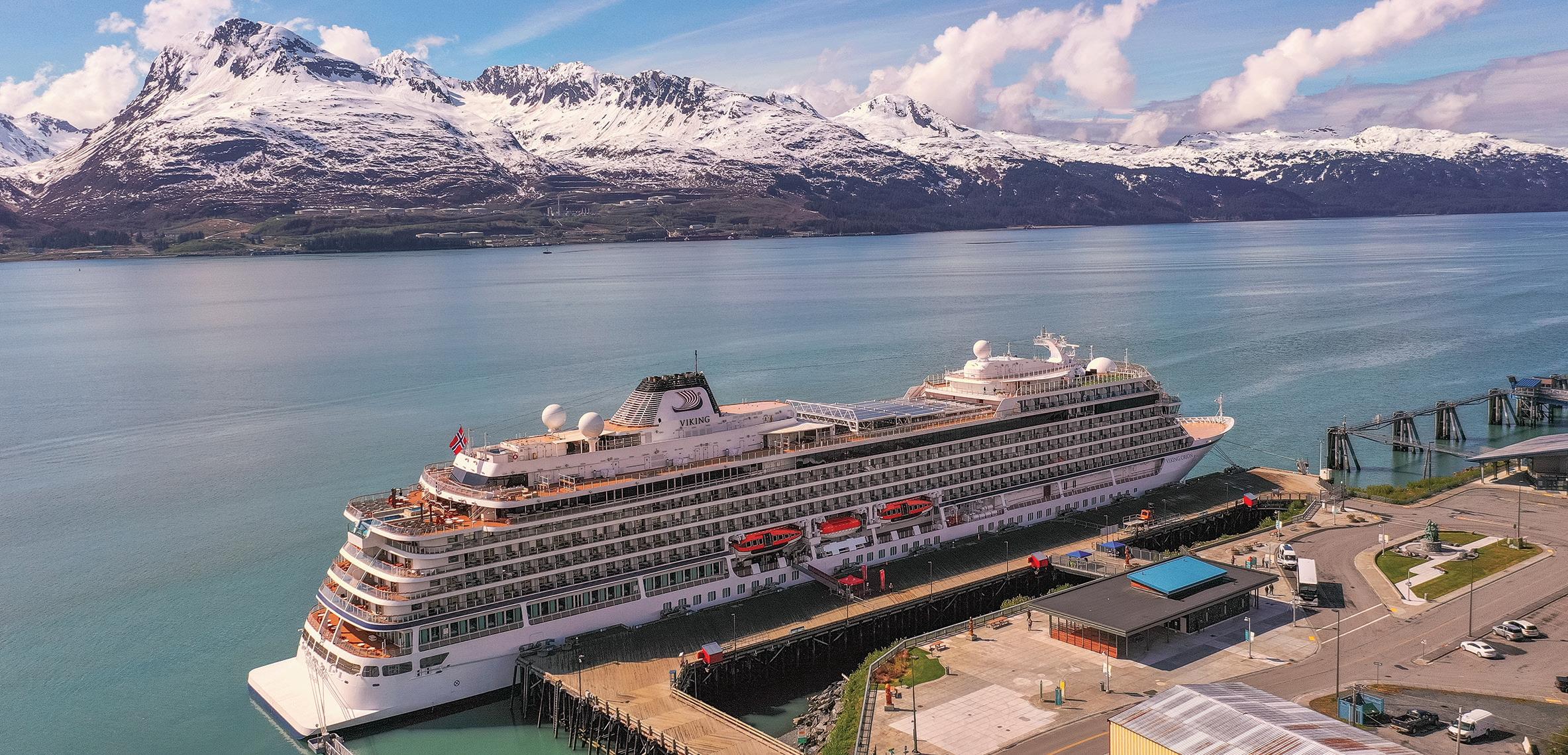
8 minute read
CRUISE INDUSTRY
Cruise industry rebound will come … it’s just a question of when
Without a doubt, few sectors have been hit as hard as the cruise industry during the pandemic. As COVID-19 spread silently around the world, the headlines were fixated on the fate of cruise ships doing their best to journey home as governments locked down their borders and fear of the unknown gripped the world. That was 2020. So, what does 2021 have in store for the marine sector that supports 1.17 million jobs worldwide and contributes over $150 billion in economic activity each year?
Impact
According to Cruise Lines International Association (CLIA), a single one per cent drop in worldwide cruising can result in 9,100 jobs lost. In a fact sheet released in June 2020, CLIA estimated that $64 billion in economic activity, 428,000 jobs and $19 billion in wages would be lost by August 2020 – that’s not even two fiscal quarters! While final numbers for 2020 are not yet published, to give just one example, third-quarter revenues for Carnival Corporation declined 99.5 per cent in comparison to 2019.
The impact on cruise destinations is equally heartbreaking. A report from the Federal Maritime Commission, released in October 2020, investigated the consequences of COVID-19 on Alaska, Washington, and Oregon. For Alaska, the cruise industry was responsible in 2019 for over $1.27 billion in direct expenditures with a total employment impact of 23,000 jobs and over $1.22 billion in wages. About 60% of out-of-state visitors to Alaska arrived via cruise ship in the year prior to the pandemic.
While the loss of the industry was felt more acutely in Alaska due to the significance of cruise as part of the overall tourism economic impact, Washington and Oregon both suffered greatly as well. To take just one example, Seattle, homeport to many ships destined for Alaska, saw 211 ship calls (serving 1.2 million passengers) in 2019 — resulting in a total economic impact of $893.6 million in revenue/business output, 5,500 local jobs and $260.1 million in
Photo courtesy of the Port of Valdez
wages as well as $14.5 million in state taxes. That business was effectively wiped out for 2020. The forecast for 2021 will be equally dismal unless the U.S. can come to an agreement with the industry and a solution to Canada’s ban on cruise ships can be found.
For Canada, the cancellation of the 2021 season was a tough announcement to hear. In February 2021, Transport Canada extended its prohibition of cruise vessels certified to carry over 100 persons to all Canadian ports until February 2022. In 2019 cruise contributed over $4.2 billion total economic impact, over 30,000 jobs and $1.436 in wages and salaries in Canada. In B.C. alone, the 2019 CLIA Economic Impact Study shows over $2.717 billion in total impact, over 17 thousand jobs and $878.6 million in wages and salaries.
While the above numbers focus predominantly on tourism and services, goods and supplies provided to the ships, the impact is also being felt on the ship building and re-fit industry, albeit the pain may not be felt for a few years. At the beginning of 2020, the number of cruise ships on order and to be delivered between 2020 and 2027 totalled 118 vessels (according to Statista Research). This was a record high for the global fleet.
“New ships continued to be completed in 2020 and 2021,” said Donna Spalding, Government Affairs and Community Relations Representative, Cruise Lines International Association - North West and Canada, during a recent presentation to members of the Association of Pacific Ports. “However, some new builds are being delayed; older ships are being decommissioned faster then might have been planned; and the future of the order book remains uncertain.” Indeed, according to the Registro Italiano Navale (RINA) Classification Society, expectations for new cruise ship orders are not expected until at least 2025.
Current conditions
During her presentation, Spalding described the efforts of CLIA member lines in working with government regulators, business partners and agencies on both sides of the border. “Cruise lines have taken a scientific approach to the resumption of operations,” she said. The first component — the initial restart of cruising — based on the development and effectiveness of protocols which are already

SHIPPING SOLUTIONS AT TWO DEEP SEA TERMINALS LINKING VANCOUVER ISLAND’S ECONOMY TO THE WORLD.

• The Port of Nanaimo ships 18 different Vancouver Island products to 25 ports in 14 countries. • Short-sea shipping to Vancouver with capacity to handle containers, bulk, break bulk, heavy lift and project cargoes. • Enhanced infrastructure providing versatility and efficiencies for diverse cargo and vessel solutions and to meet a growing container business both locally and globally.
LOCAL BENEFITS — GLOBAL REACH
For Cargo and Terminal oppportunities, please contact: Jason Michell, VP - B.D. (250) 734-3457 JMichell@npa.ca

100 PORT DRIVE, NANAIMO, BC

providing for the successful return to cruising in Europe and areas of the South Pacific; in addition will be the availability of effective treatments and vaccines. Lines are considering ship configurations and sanitation procedures which may include designated isolation cabins. Management of onboard populations will require consideration of physical distancing as well as crew training, frequency of testing, and guidelines on the use of personal protective equipment. A final, key component would be communications throughout the full spectrum of the cruise experience — from booking, to embarkation, to onboard activities and destination regulations.
Spalding also spoke about the conversations between the CLIA members and the U.S. Centers for Disease Control (CDC) following the release of a Framework for Conditional Sailing in October 2020. Technical Instructions, released in early April 2021, establish close to 50 requirements to be met before receiving “controlled free pratique to conduct one or more simulated voyages or restricted passenger voyages,” including documented approvals from U.S. port and local health authorities where the ship intends to dock; vaccination of all eligible port personnel and travelers (both crew and passengers); and the incorporation of clear protocols and safety measures both in port and on board.
Other factors are also at play outside of the cruise industry’s control. Border closures, health advisories, restrictions of air travel and testing requirements for people coming into countries continue to impact the return of cruising. Another important factor: the status of the pandemic. If the numbers hold steady, improving conditions are providing cause for some newfound hope.
Forecasting the future
Although some lines have already resumed in some parts of Europe and Asia, including MSC and Costa, most of the larger lines have set a June 2021 date for resumption of cruises, with some exceptions including New Zealand, Australia, Canada, and South America. In early March, the U.K. maritime minister, Robert Courts, announced the return of domestic cruises “to help the cruise industry restore confidence and highlight robust protocols implemented by cruise lines for passengers and crew.”
Cruise Critic (cruisecritic.com) publishes frequent updates on expectations for when cruise lines will resume service. As of April 1, the schedule is a mixed bag and comes with no guarantees. For example: • Carnival Cruises expects to resume by June 2021 with several exceptions: Carnival Legend’s European itineraries have all been cancelled;
Carnival Miracle’s planned seasonal service from San Diego has been suspended until further notice, and sailings out of San Diego that were available for sale through April 2023 have been canceled, with the exception of seven voyages to
Hawaii, which will move to Long
Beach; Carnival Radiance’s dry dock work was delayed, pushing the planned arrival to Long Beach back to November 2021; and Australia voyages aboard Carnival Splendor are cancelled through to June 28, 2021, while sailings aboard Carnival Spirit are “paused” through to September, 2021. • Celebrity has posted a resumption date of June 1, 2021 but have confirmed that sailings in Asia, Australia, New Zealand and South America are cancelled for the 2020/21 season as is the
Transatlantic crossing on Apex and the May through October 2021
Europe and transatlantic cruises on
Celebrity Edge and Constellation.
On the positive side, voyages aboard
Celebrity Millennium will begin from St. Maarten on June 5, the
Celebrity Apex from Athens on June 19, and the Celebrity Silhouette from
Southampton, U.K. from July 3, 2021. • Crystal Cruises ships have start dates that range from July to September 2021. • Cunard Line is planning to run the
Queen Elizabeth on new U.K.-only voyages through the summer; and expects to have the Queen Victoria sailing by September 10, 2021, and the Queen Mary 2 by November 14, 2021. • Disney reports that the Dream and
Fantasy will start in June, and the
Magic will begin U.K.-only “staycation” voyages at the same time.
Disney’s Alaska-bound cruises, while keeping reservations intact, have been removed from the booking engine and are still being evaluated. • Holland America has plans to start back up in May 2021 with some
European cruises starting in July.
HA has confirmed cancellation of all cruises departing or ending in
Canada; and all cruises departing from Seattle are cancelled through the end of June 2021. • Norwegian Cruise Line also expects to resume sailings in July 2021 except for the Encore, Jewel and Jade which have been pushed back to an
October/November timeframe.
If the past year revealed anything to us, it is the difficulty of predicting the future. As Spalding noted in her presentation, concepts such as vaccine rollout, flexibility, resiliency and continual communications will be key to industry resumption as the world moves through the second — and hopefully final — year of the pandemic. PP










